10. Systems: Open or closed?
In this chapter I want to discuss something that at first you might not think has much to do with your family and peoplemaking. Stay with me. The concept of systems was borrowed from the world of industry and commerce. It has become a way of understanding how human beings in groups work.
Any system consists of several individual parts. Each part is essential and related to each other part to attain a certain outcome; each acts as a stimulus to other parts. The system has an order and a sequence which is determined
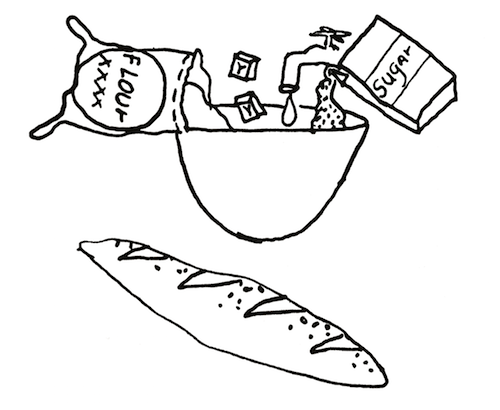
through the actions, reactions, and interactions among the parts. This constant interplay governs how the system manifests itself. A system has life only now, when its component parts are present.
Sounds confusing? It isn’t really. You put yeast, flour, water, and sugar together to make bread. The bread isn’t like any one of its ingredients, yet it contains all of them.
Steam isn’t like any of its parts, but it contains them all.
All human life is part of a system. We hear a lot about beating the system, which would seem to say that all systems are bad. Not so. Some are and some are not. The implications of systems thinking for personal, family, and societal behavior are evident everywhere today; in the early Seventies, when this book first came out, they were just beginning to be apparent.
An operating system consists of the following:
A purpose or goal. Why does this system exist in the first place? In families, the purpose is to grow new people and to further the growth of those already here.
Essential parts. In families, this means adults and children, males and females.
An order to the parts’ working. In families, this refers to the various family members’ self-esteem, rules, and communication.
Power to maintain energy in the system so the parts can work. In families, this power is derived from food, shelter, air, water, activity, and beliefs about the emotional, intellectual, physical, social, and spiritual lives of the family members and how they work together.
Ways of interacting with the outside. In families, this means relating to changing contents, the new and different.
There are two types of systems: closed and open. The main difference between them is the nature of their reactions to change, both from the inside and from the outside. In a closed system, the parts are rigidly connected or disconnected altogether. In either case, information does not flow between parts or from outside in and inside out. When parts are disconnected, they often appear as if they are operating: information leaks in and out but without any direction. There are no boundaries.
An open system is one in which the parts interconnect, are responsive and sensitive to one another, and allow information to flow between the internal and external environments.
If one were to deliberately design a closed family system, the first step would be to separate it as completely as possible from outside interference, and to rigidly fix all roles for all time. The fact is, I don’t believe anyone would deliberately design a closed system. Closed family systems evolve from certain sets of beliefs:
People are basically evil and must be continually controlled to be good.
Relationships have to be regulated by force or by fear of punishment.
There is one right way, and the person with most power has it.
There is always someone who knows what is best for you.
These beliefs are powerful because they reflect the family’s perception of reality. And the family then sets rules according to their beliefs. In other words, in closed systems:
Self-worth is secondary to power and performance.
Actions are subject to the whims of the boss.
Change is resisted.
In open systems:
Self-worth is primary; power and performance, secondary.
Actions represent one’s beliefs.
Change is welcomed and considered normal and desirable.
Communication, the system, and the rules all relate to each other.
Most of our social systems are closed or very nearly so. A little change is allowed, which in my opinion is the reason we have been able to limp along as well as we have.
Now we come to an important philosophical question. Do you believe that all human life deserves the highest priority? I believe this with all my being. Therefore I unashamedly admit I will do everything I can to change closed systems into open ones. An open system can choose to be open or closed when it fits. The important word is choice.
I believe that human beings cannot flourish in a closed system; at best, they can only exist. Human beings want more than that. The task of the therapist is to see the light that shines in every person or family, and to uncoil the wrappings that shroud that light.
Right now you and I could point to countless examples of closed systems, including dictatorships in current society, schools, prisons, churches, and political groups. What about the system in your family? Is it open or closed? If your communication now is mostly growth-impeding and if your rules are inhuman, covert, and out of date, you probably have a closed family system. If your communication is growth-producing and your rules are human, overt, and up to date, you have an open one.
Let’s return to an exercise we’ve done before and do it again with different goals and different reasons for doing it. Ask your family members or any other five people to work with you. They can be a family or coworkers or a board of directors. As before, ask them to take different names and to pick one of the growth-impeding communication styles (placating, blaming, computing, or distracting). Try planning something together for ten minutes.
Notice how quickly the nature of the system emerges. Before I was asking you to do this with three people to see what happened to you individually. This time you might begin to see how closed systems develop. In addition to your back hurting, your head aching, and not being able to see and hear well, you may begin to feel locked in. People look like strangers or burdens. They are not giving each other information, only grief.
Now try the same planning experiment with the leveling response. Can you see the beginnings of an open system? In contrast to your experience in the closed system, you may feel more loose, more lucid. Your body probably feels better and you may be breathing easier.
The following chart shows how the closed system applies to troubled families, and the open system to nurturing families.
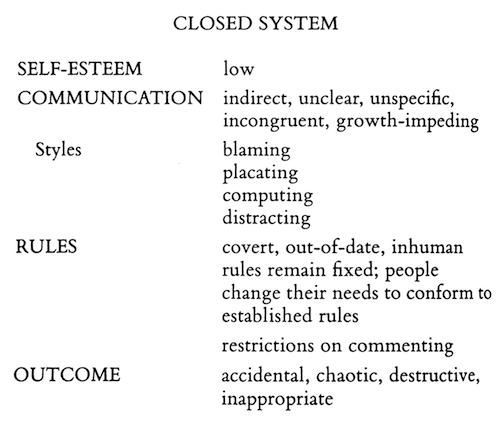
Self-worth grows ever more doubtful and depends more and more heavily on other people.
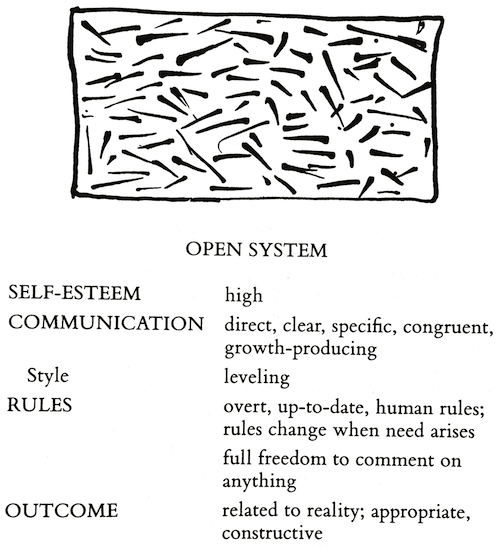
Self-worth grows ever more reliable, confident, and draws increasingly more from the self.

All right. When three or more people are related in any way and are joined in one common purpose, they will de- velop into a system. This happens in families, with friends, and at work. Once established, the system remains very much in operation, even when not in evidence. If it’s a closed system, it will probably operate on a life-death, right-wrong basis; fear permeates the atmosphere. If open, it probably operates on the basis of growth, intimacy, and choice.
Put very simply, your self-worth, your communication, together with your rules and your beliefs, are the ingredients that make up your family system. Leveling communication and human rules characterize an open system and allow everyone in that system to flourish. Crippling communication and inhuman rules make a closed system, retarding and distorting growth.
Becoming aware of their system usually opens the way for family members to become searchers and to stop berating themselves and others when things go wrong. People can ask “how” questions instead of “why” questions. Generally speaking, “how” questions lead to information and understanding, and “whys” imply blame and so produce defensiveness. Anything contributing to defensiveness contributes to low pot and leads to potentially unsatisfying outcomes.
Another important part of any system is that it tends to perpetuate itself. Once established, a system will stay the same until it dies or something changes it: a part breaks down from lack of care or because of a defect; or a catastrophic event affects the system. Sometimes even a minor incident can overwhelm the system, which indicates that the system’s designers behaved as though change would never happen.
Each member in a system is a most significant factor in keeping the system going as it is or changing it. Discovering your part in the system and seeing others’ parts is an exciting, although sometimes painful, experience. And you can certainly see the importance of systems when you consider the very life of the family depends on its system to a very large degree.
Let’s look at the family system in another Way. Maybe another comparison would help at this point.
In a mobile all the pieces, no matter what size or shape, can be grouped together in balance by shortening or lengthening their strings, rearranging the distance between pieces, or changing their weight. So it is with a family. None of the family members is identical to any other; each is different and at a different level of growth. As in a mobile, you can’t arrange one member without thinking of the others.
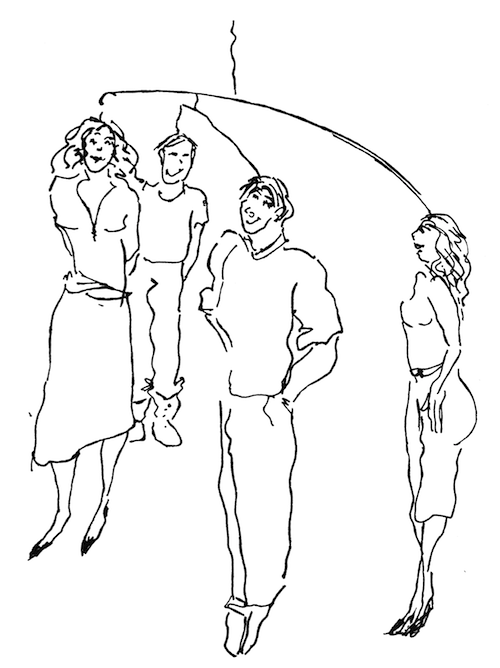
Try this. Take objects——any ohjects——that are very different from one another and work out a balance for them. Take as many as there are different people in your family, and think of them as your family members. The more parts to your mobile and the greater the differences among them, the more variety and interest you will have.
If you settle for the first balance you achieve, you’ll be doing what so many people do: making the only way they know the “right” way. You resist other ways to bring balance to your family because you fear experimentation.
To avoid this bind, find at least two more ways to make the pieces balance. Many more ways exist, but I will have made my point if you find three. You now have three options, and you need not be stuck with only one.
The trick of making a vital family system is to enable each family member to have a truly individual place and to have fun in that place. Bringing off this trick entails your ability to change and to adjust the “strings” in your family mobile. The strings are your feelings, rules, and communication patterns. Are they immovable or flexible?
While you are working on your mobile, think of the parts of a family. They can be divided into two major categories: adults and children, then males and females. Even the most casual glance at this array shows a great diversity in what people have to give each other at any point in time.
No established rule says one person has to do all the giving and everyone else all the getting. Yet some families cripple themselves by appointing a specific person to be the giver, and nothing ever changes. Ordinary life is such that even if someone agreed to do so, he or she couldn’t always give without great cost. One time it may be only the hus- band who is able to give; another time it may be only the wife or one child. Many families have rules that dictate who may give to whom:
Boys always give to the girls.
Mother always gives to the children.
Husband always gives to the wife.
Eventually, everyone gets cheated. However, if the ideal outcome of a family today is the growth of all its members, then the family job is to use all its parts to ensure this growth.
How can adults use themselves so the children can grow? How can the children use themselves so the adults can grow? How do the males make development possible for the females and the females for the males? How does everyone help everyone else——adult, child, male, and female alike? These are significant questions in families’ efforts to become more nurturing.
Each of these groups has a world that members of the complementary group do not share. Talking about respective worlds, offering their variety and stimulation, not only adds interest but also expands our whole reality. No woman knows what it feels like to carry around a penis, and men don’t know what it’s like to carry babies. Far too many adults have forgotten how to enjoy the simple pleasures children find in life. Simple sharing among groups can help greatly in these areas.
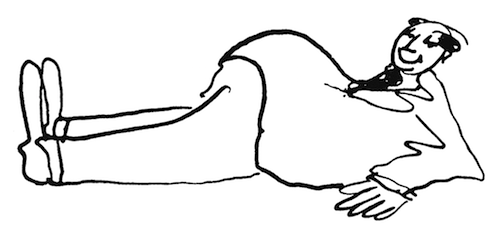
All families are in balance. The question is: What is the cost to each family member to maintain that balance?
I think the stakes are high regarding the nature of your family system. The family is the one place in the world where all of us can expect nurturing: soothing bruised souls, elevating self-worth, as well as getting things done.
The family is the obvious place to learn this nurturing and growing. To achieve these goals and become truly vital, there has to be continual observation and changing and reshaping in the family. This can only take place in an open system.